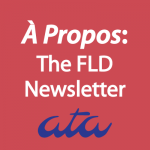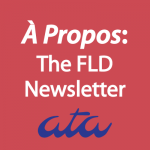
 To make our Continuing Education Series Podcast more accessible and searchable for FLD members and the general public, we are now offering transcriptions of our episodes right here on À Propos. Many thanks to our volunteer transcriptionists, who are credited at the bottom of each transcription. If you’re interested in helping us transcribe podcast episodes, email divisionFLD [at] atanet [dot] org.
To make our Continuing Education Series Podcast more accessible and searchable for FLD members and the general public, we are now offering transcriptions of our episodes right here on À Propos. Many thanks to our volunteer transcriptionists, who are credited at the bottom of each transcription. If you’re interested in helping us transcribe podcast episodes, email divisionFLD [at] atanet [dot] org.
HOW TO LISTEN TO THE ORIGINAL EPISODE
SOUNDCLOUD: You can listen to or download Episode 30 and all previous episodes on Soundcloud here.
ITUNES: This episode and all previous episodes are available on iTunes here. You can subscribe or listen online. Like what you hear? Rate us and review us! It really helps get the word out.
Episode 30: Museum Translations with Multitalented Susan Pickford
Andie Ho: Today we’re joined by Susan Pickford, who is from the UK, but she’s been living in France since the late 90s after earning a degree in French and German. She worked in publishing for a short while before beginning translation in 2001—I guess she saw the light—using her publishing background as a springboard. She joined the Louvre translation team in the early aughts, when they were setting up the museum’s first big website, and the rest is history. Susan also has a PhD in Comparative Literature and taught English at various universities, before landing a tenured position in translation studies in 2007. And now she runs the English Unit at the University of Geneva, where I attended a semester. Fabulous memories there at the what is now called the Faculté de traduction et d’interprétation. Welcome, Susan.
Susan Pickford: Thank you. I’m so pleased to be here.
Andie Ho: So you have a very interesting and varied background and career, and we’re going to get to all of it. But let’s start with the beginning. So first you started working in publishing before parlaying that into a career in translation. So how exactly did you work that transition? How did you use your publishing world experience to leverage that into a second career?
Susan Pickford: Well, to start off with, I mean, I have to say I was pretty low in the food chain when I was in publishing. I was in Paris, and I only worked in publishing for a year. But it was, to be honest, it was an excellent grounding in sort of the whole publishing ecosystem, I would say, because I was pretty much the dogsbody who did, you know, did the photocopying and went to the other departments and so on. But it really gave me an overview of the whole thing, how it hung together, where translation in particular fitted into it. I was working in a department where we produced translation or translated books in house, illustrated books, coffee table books, I’d guess you call them. And so I sort of got a sense of the economy of it and how translation really slotted into that. While I was there, I did a lot of editing, sort of language editing on the translations that came in. And I also did a little bit of translation myself. And I would say that was also super helpful because it was really broad.
Susan Pickford: There were books on everything from, you know, rose varieties, model trains, lighthouses. It was a really good broad grounding in how to write for a general audience. And it also made me think about, who am I writing for? What do they need to know? So I’d say that was a really, really good place to start. And the other thing that it taught me is that I’m really not cut out for a 9-to-5 office job. So that kind of propelled me into further study, which is sort of my other strand in life, working in academia. So from there, I started, I went back and did my PhD, and I funded my PhD largely by working in translation, starting out mostly for the same publisher in Paris, but also then it snowballed from there as I built up contacts and worked a lot with a sort of informal network of people working in the same sort of sector in Paris at the time.
Andie Ho: So you said you learned where translation slots in into the publishing industry. Where does it slot in?
Susan Pickford: That’s a very good question. I mean, I think we tend to think to think of translation as sort of an isolated phenomenon, but actually it’s really much, very much a part of a chain of command where you have exactly as in business translation or in other sectors. When we’re looking at publishing translation, you have a commissioner, somebody who wants to buy the project. You have people who are going to be editing your text. You then have buyers who you have to write for, et cetera. So you’re never working in isolation, even if you’re doing literary translation, you’re always working in a chain of command. And I think we sometimes forget that and I think it’s important to bear it in mind.
Andie Ho: Now, speaking of literary translation, you were also on the French literary translators association board for 10 years. Can you tell us about that?
Susan Pickford: Sure. So, as I was saying, we do think of translators, you know, people think that we work at home in a kind of ivory tower, but that’s really not true in my experience. I mean, I’ve always worked in teams. It’s part of, I think, part of the arts sector as well. That’s one of the characteristics, that they’re big projects and you’re often working, working to short deadlines. So I do work a lot in teams, and I’ve always had that sort of ethos of advocacy and service for the profession, because I’ve always thought that if you want to be taken, if translation wants to be taken seriously as a profession, it needs to foster that kind of collective shared ethos and values, which are sort of core, a core definition of what a profession is. We don’t sign a Hippocratic oath, but we can work towards having a collective shared set of values. And that’s really what I thought about when I was joining the French translation association. It’s kind of the idea of a rising tide lifts all boats. You know, if we’re all working together for better conditions, then it works for everybody. And I have to say, doing that, I’ve also had a lot of work through it. I’ve also passed a lot of work on from it. So I think that collective sort of seeing what we do in that collective perspective is super helpful all around.
Andie Ho: Yeah, it’s so super important when the majority of our days is us and the four walls. You know, talking to ourselves to really make it a point to get out there and connect.
Susan Pickford: Absolutely. It’s so important. You know, from a mental health perspective, fitness perspective, connecting with others, the human side of it is so important.
Andie Ho: Now, you have said that the majority of your clients currently or in the past even have been museums and opera houses, various cultural institutions. So I assume that decision was influenced by your early work on the Louvre project?
Susan Pickford: Pretty much. I would say it’s, I kind of fell into it, but it really suited me as well. So I think it’s, you know, it’s a good thing that I came into this from my perspective. I have always been interested in the arts. You know, I’m a keen museum-goer. So can’t say it was a deliberate decision to make that my speciality. But yeah, having worked on the Louvre project and having built up a network of people who are also working in similar areas. Yes. It just sort of fell naturally into place. And I have to say, it’s super interesting, super varied. You know, there’s a lot of work in the sector which is really very varied and very interesting.
Andie Ho: So in addition to museums and opera houses, who are your clients and what kind of projects do you do for them?
Susan Pickford: Well, at the minute, it really has been museums. I have been heavily working in that sector. I mean, do occasional things for record labels, operas, a little bit of music on the side as well. But the vast majority of my work is for a sort of core set, I would say, of six or seven museums that I have a good long-standing working relationship with. So, you know, big museums in Paris, which have a lot of work, obviously, because, you know, these are huge international visitor attractions. Also, now since I moved down to live near Switzerland, I work a lot with Swiss museums as well. So that’s really the bulk of where my work is now is in museums and the sort of thing I do, I do wall panels for exhibitions, temporary exhibitions. I do a lot of catalogues, a lot of website content, because obviously they have , you know, exhibitions that are constantly changing. They have to bring new visitors in with new attractions, new content. So there’s kind of an ongoing rolling stock of work that needs to be done. Plus the sort of bread-and-butter work of updating websites in terms of COVID restrictions and updated accessibility statements and things like that. So I tend to work less on those. But there is some of that as well, some more of the sort of pragmatic side of visitor attraction work.
Andie Ho: So you said there was a certain chain of command in publishing. Is that the same also in museum work?
Susan Pickford: Pretty much yes. A lot of the big museums I work for have their own publishing branches or their own publishing departments. I tend not to deal with those so much these days. I would pretty much be talking to one person who is often a curator at the museum, particularly if it’s a smaller museum. A lot of the bigger ones, as I say, the Louvre will have its own publishing branch and then I’ll be dealing with them. But since I stopped working in publishing, I have much less contact with that broader chain of command. It’s really now me talking to my contact at the museum.
Andie Ho: So how do museum clients or cultural institution clients differ from more commercial clients, would you say?
Susan Pickford: Well, I’d say there’s a question of status in that they tend to be nonprofits or state- run. So I have to say, in the French context, that means there can be a lot of admin involved in terms of billing, things like that. There are some real specific aspects to museum translation. So things like space constraints when you’re working on wall panels, you know that you’ve only got so many characters that you can play with. And you also have to be aware of the fact that you’re writing for often, in a lot of cases, a very international audience. So you know that Chinese visitors, for instance, will be mediating or will be accessing the art through the English. So you have to bear that in mind in how you write and how you gloss things. And, you know, you have to explain who various historical characters are that are in paintings for an international audience, but then keeping that within the space constraint that you have on the wall panel, that sort of thing. So that can be quite a challenge. I would say that another thing that is specific about the work is it can be highly technical when you’re talking, for instance, about pottery-glazing techniques, that sort of thing. But it could also be very, very creative when, you know, I had one project a couple of years ago, for instance, where it was an imaginary index of objects that you might find in a surrealist painting, and then it needed to be, there was lots of wordplay and the whole thing needed completely rewriting.
Susan Pickford: So you have to be sort of a master of a lot of skills. The things I’ve worked on in the last couple of years, philosophy of architecture for a journal that I work with regularly, 18th-century furniture, 19th-century photography. I did an exhibition on wampum beads for a place in Paris last year. So you have to be really on top of trends in the art world. I think that’s important contemporary art in particular. But you also have to be super skilled at getting very good at things you don’t know much about very quickly. Before I did the Wampum Beads exhibition, I could hardly have told you what they were. But, you that’s one of the skill sets, is really developing expertise very quickly with that sort of background knowledge of the fundamentals of art and art vocabulary. I think that’s one of the most important things. I would say that one thing that is specific about it as well is that I never use any CAT tools. I think it’s one of the rare sectors where they’re not necessarily very, very useful because kind of by definition, the repeatability of the kind of texts I work on is very, very low. So there’s not a lot of point in investing in CAT tools at the minute for me. So I do it all old school by hand.
Andie Ho: But what about glossaries? Do you maintain glossaries?
Susan Pickford: I personally don’t because I kind of started my career before they were a thing, 20 years ago. So I’ve honestly never quite got into it. I maintain them sort of informally, but don’t have any tools that do that for me.
Andie Ho: It’s all in your head, huh?
Susan Pickford: All in my head, yeah.
Andie Ho: Impressive. Yeah, the few times, you know, in my younger days, I accepted some projects translating some artwork because I thought it would be easy, I thought it would be “soft.” I think a lot of people do. And I was shocked by how technical it is. And I find, for me, at the time at least, it was even harder to find those technical terms than it would be for a piece of machinery.
Susan Pickford: Sure. Yeah. You have to be good. I mean, now, you know, when I started out, Google was barely a thing. So you did spend a lot of time doing research. Now, you know, 20 years down the line, it’s a lot easier than it was, looking up terms. There are good bilingual dictionaries out there that you can access. But by and large, when you’ve been working in the sector for a long time, you do know a lot of the background stuff. And I also know now to refuse projects where I’m not going to be comfortable with the level of technical language. So, for example, there are some architecture-type projects that would say no to these days, because I just know that I’m going to spend a lot of time looking up terms for 12th-century church architecture and I’m quite happy to pass that kind of text on to other colleagues who are very good at it these days.
Andie Ho: No matter how long I’ve been in translation, I’m still constantly shocked by the obscurity of the texts that we can receive. That’s part of what makes it fun.
Susan Pickford: It is. Absolutely. I mean, the sheer variety of jumping from subject to subject and being an instant expert in things, I find that instant, you know, it’s constantly super gratifying for me. Yeah.
Andie Ho: So you talked about the other half of your life. You also work at the Université de Genève in Geneva. So what exactly are your responsibilities there?
Susan Pickford: Okay, so I’ve been in Geneva now, this is my third year just starting. I run the English unit, which runs the M.A. in translation from French and Spanish to English in legal and financial and economic translation. Geneva actually has one of the oldest translation schools in the world, started back in the immediate post-war period, and it’s now become a full faculty. So I am head of a team of 10 translators who teach. I’m the full-time person at the university, and then my colleagues are all people who are working at the various international institutions that we have in Geneva. So people who are working at the World Health Organization, at the Red Cross, at the International Labor Organization and so on, who will come in and teach in their special area of expertise. So that, again, is super gratifying. And because I’m an academic as well, I do some research as well alongside that and I teach as well. I teach undergraduates translation. Yeah.
Andie Ho: So what courses do you teach?
Susan Pickford: At the moment? I’m teaching Thèmes, which is French, to English translation for undergraduates. And then I also teach translation, revision, and translation criticism later in the year.
Andie Ho: And what is your area of research?
Susan Pickford: So my research focuses on translation sociology, particularly translator sociology. So I’m super interested in, because I’ve always been at the crossroads of practice and research. I’m super interested in translator careers, how people, you know, who gets to translate what, what kind of content and in what conditions and particularly what sort of economic conditions. So I’m super interested in issues of workflow, timing, how people get to choose the, do people get to choose the projects they work on? At what stage in your career can you afford to say yes or no to things you know? Can you work in literary translation particularly? Can you work in it full time? Can you describe yourself as a professional literary translator if it’s not your main source of income? So sort of theorizing around those issues is what I’m working on at the minute.
Andie Ho: That is so interesting. Do you also look at the geographical level? Because just off the bat, I mean, for instance, Europe and America, the landscapes are so different.
Susan Pickford: Absolutely. I work mostly in the European context, to be honest, because, you know, that’s where I am. But I know the landscapes are very different. I mean, even just things like, aspects that are very little discussed, but things like the tax setup, health care setup, which means that in Europe you might be able to afford to start a career in a different way than you would in the States. And that’s not even getting into other parts of the world where I really don’t have the knowledge to talk about them. But these are interesting and important questions that I think we need to spend more time talking about in the profession.
Andie Ho: Absolutely. Okay. Final question that I ask everybody. What do you want to leave the listeners with? What would you like them to know?
Susan Pickford: I do have one thing that is quite exciting, the most exciting thing that’s happened to me in my translation career so far, is that last year, I translated a novel for the first time, a full-length novel by a Belgian author called Barbara Abel. And the book is called Mother’s Instinct, and it’s coming out soon as a film, a Hollywood film starring Jessica Chastain and Anne Hathaway. It’s been a little bit delayed by the strikes, but you know, you’ve got to support that. So it’s out soon. Look out for that. And I’m super stoked that that’s happened.
Andie Ho: Oh my gosh, that’s so exciting.
Susan Pickford: I know, I hope I get invited to the premiere. I mean I’m looking out for an invitation.
Andie Ho: I forget what movie I was watching recently. Oh, it was A Man Called Otto. That’s the English, American title. A Man Called Ove is the Swedish title. And I watched the trailer, I read the English version, and then I watched the trailer, and I recognized the exact dialogue from the English translation of the book spoken by Tom Hanks. So do you know if Jessica Chastain and Anne Hathaway are speaking words that you wrote?
Susan Pickford: I suspect not. They’ve got someone else, they got someone to do the screenplay, and then they bought the rights to the French book, because it’s actually a remake of a Belgian film from a few years ago. So I have to say, my involvement in the film is kind of peripheral. So, you know, that invitation may not happen, but still it’s…
Andie Ho: They might have taken it though from your…
Susan Pickford: Yeah, yeah, I’m going to gatecrash. If not, I’m going to take the train to Paris and gatecrash.
Andie Ho: All right. Well that’s very exciting. So everybody check out that book. What’s the French title of the book?
Susan Pickford: Derrière la haine.
Andie Ho: Okay. All right.
Susan Pickford: Yeah, complete change of title.
Andie Ho: Translated by Susan Pickford. Check it out.
Susan Pickford: Absolutely. It’s out there.
Andie Ho: All right, well, thank you so much, Susan, for joining us today and telling us all about your very interesting career.
Susan Pickford: Well thank you, Andie. It’s been an absolute pleasure.

 To make our Continuing Education Series Podcast more accessible and searchable for FLD members and the general public, we are now offering transcriptions of our episodes right here on À Propos. Many thanks to our volunteer transcriptionists, who are credited at the bottom of each transcription. If you’re interested in helping us transcribe podcast episodes, email divisionFLD [at] atanet [dot] org.
To make our Continuing Education Series Podcast more accessible and searchable for FLD members and the general public, we are now offering transcriptions of our episodes right here on À Propos. Many thanks to our volunteer transcriptionists, who are credited at the bottom of each transcription. If you’re interested in helping us transcribe podcast episodes, email divisionFLD [at] atanet [dot] org.

